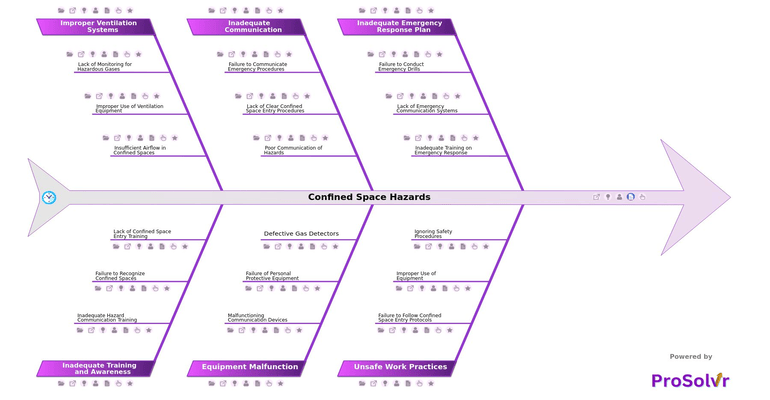RCA of Confined Space Hazards
In the petrochemical industry, confined spaces such as storage tanks, silos, reactors, and pipelines are common but pose significant hazards due to limited ventilation, restricted access, and the presence of dangerous substances. The primary risks include toxic gas exposure, oxygen deficiency, and explosive atmospheres, all of which can have fatal consequences if not properly managed. Workers entering confined spaces face dangers like suffocation, poisoning, or burns, and rescue operations are often challenging due to restricted entry and limited space. These conditions increase the likelihood of accidents, emphasizing the need for rigorous protocols for entry, work, and emergency procedures.
The most critical underlying causes of confined space hazards include inadequate emergency response plans, improper ventilation systems, and insufficient training and awareness. For instance, a lack of monitoring for hazardous gases, insufficient airflow, and failure to conduct emergency drills significantly increase the risk of incidents. Unsafe work practices, such as ignoring safety procedures and failing to follow confined space entry protocols, further exacerbate these dangers.
Root cause analysis (RCA) using tools like a fishbone diagram is instrumental in identifying and addressing these hazards. By systematically investigating past incidents, RCA uncovers the underlying factors contributing to unsafe conditions. For example, RCA might reveal that defective gas detectors, poor communication of hazards, or insufficient training on emergency response led to previous incidents. Addressing these root causes enables targeted preventive actions to reduce risks and improve safety protocols.
Integrating RCA with Six Sigma principles further strengthens safety programs by identifying recurring issues and implementing permanent solutions. These solutions may include better engineering controls, improved PPE standards, and more effective operating procedures.
Who can learn from the Confined Space Hazards template?
Root Cause Analysis (RCA) of Confined Space Hazards in petrochemical plants provides valuable insights for various stakeholders
- Operations and Maintenance Teams: These teams, responsible for equipment checks, confined space entries, and ongoing maintenance, will benefit from improved safety protocols, clearer communication, and access to safer, better-maintained equipment, reducing their risk of injury.
- Safety and Health Officers: By using insights from the RCA, safety officers can refine emergency response plans, enforce PPE standards, and ensure safety training is tailored to mitigate the identified root causes, helping them create a safer workplace.
- Emergency Response Teams: With enhanced training and clearer emergency procedures, these teams will be better prepared to handle confined space incidents efficiently and effectively, reducing response time and improving worker safety.
- Training and Development Staff: The RCA findings allow training departments to target specific weaknesses, improve hazard communication, and conduct more comprehensive training sessions, leading to a workforce better prepared for confined space challenges.
- Plant Management and Supervisors: Management gains insights to address recurring safety issues, improve compliance with safety standards, and foster a proactive safety culture, ultimately reducing liability and enhancing productivity by minimizing incidents.
- Compliance and Regulatory Auditors: RCA-driven improvements help auditors by ensuring safety practices align with industry regulations and standards, providing documented processes and proof of ongoing risk mitigation efforts to meet compliance requirements.
Why use this template?
With ProSolvr, a Generative AI-powered Root Cause Analysis (RCA) application, the petrochemical industry gains a powerful tool to enhance safety protocols. ProSolvr simplifies hazard identification, visualizes RCA findings, and supports the identification of Corrective and Preventive Actions (CAPAs). By continuously improving confined space entry protocols, ProSolvr helps reduce the likelihood of serious incidents, safeguard workers’ health, and foster a culture of safety excellence.
Draft and create a template for problem analysis in ProSolvr by smartQED.








